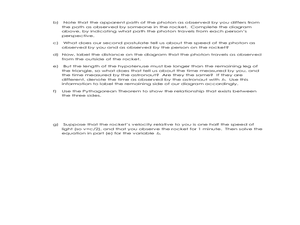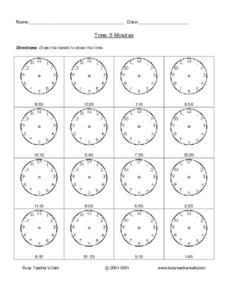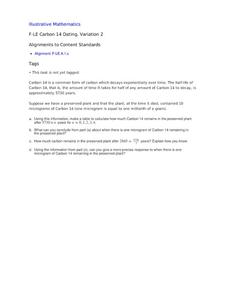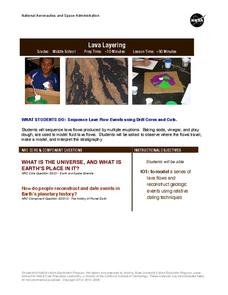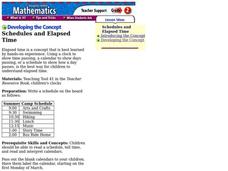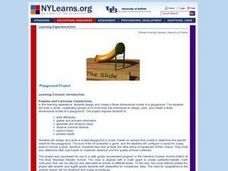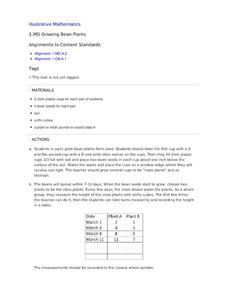Illustrative Mathematics
Accuracy of Carbon 14 Dating II
The scientific issue of carbon-14 dating and exponential decay gets a statistics-based treatment in this problem. The class starts with a basic investigation of carbon content, but then branches out to questions of accuracy and...
Curated OER
It's About Time!
Young scholars examine concept of time, and explore difference between analog and digital clocks; students make art project to represent time and create a time-story problem and solution.
Curated OER
Time Dilation and Geometry
Students solve problems of dilation and velocity. In this geometry lesson, students apply the Pythagorean Theorem to solve problems and relate it to time and velocity.
Curated OER
Carbon 14 Dating
Evaluating and analyzing exponential functions will help your archaeologists find the amount of Carbon 14 remaining in a plant in this real-life task centered on carbon dating. Learners will also be introduced to the concept of half-life.
Franklin College
Tell Time to the Nearest Half-hour and Relate to Events
Youngsters examine how to tell time to the nearest half-hour. They discuss why people wear watches, listen to the book "What Time Is It?" by Sheila Keenan, view examples on a model clock, and complete a worksheet with the teacher.
Curated OER
Time Zones
In this time zones worksheet, students are given a map of the Earth indicating the time zones, the prime meridian and the international date line. Students answer 5 questions about solar occurrences and determine when each would be seen...
Curated OER
Time 5 Minutes
If your learners have already been introduced to telling time in five-minute intervals, this resource will provide extra practice! Or consider using it as a formal assessment. Have your learners developed time-telling skills?
Curated OER
Carbon 14 Dating, Variation 2
Your archaeologists begin this task with a table of values to estimate the time passed based on the half-life of Carbon 14 remaining in a plant. They then move on to find when a specific amount of Carbon 14 is present in the same plant,...
NASA
Lava Layering
Take the old baking soda and vinegar volcano to the next level by using it to study repeated lava flows over time, examine geologic features on Earth and Mars, and speculate about some of the formations on Mars.
Curated OER
Just a Minute!
Young scholars put the standard measure of clock time -- the minute -- in perspective. This lesson can be modified for virtually any grade level. They write about what they learned about a minute as a result of the activities.
Curated OER
"Andy Works for Charity"
Explore a real-word math problem with your class. Strengthen their problem-solving strategies by coming up with an answer to a money question. They work in groups to determine the answer. Also, they share with the class the various...
Curated OER
Schedules and Elapsed Time
Students answer questions about elapsed time in the calendar. In this elapsed time lesson plan, students discuss a schedule that is given to them, and then answer questions about time passing on a March calendar page.
Curated OER
Time Zones
Students are able to read and also use a variety of timetables and charts. They perform calculations with time, including 24-hour clock times and time zones. These are very important concepts that Students probably have to bear in mind...
Curated OER
Time Basics Review
In this basic mathematics worksheet, students identify the basics of telling time. They read a watch and figure out three hours later from that time. Students also write the times given using both words and numbers for each watch shown.
Curated OER
Calendar Time
Use circle time to work on counting. Kindergarteners practice the months of the year, say the full date, chart the day's temperature, count to 100, and sing the alphabet song. This kind of daily routine cultivates deep roots for...
Perkins School for the Blind
Circle Time
Oftentimes children or teens with one or more disability are reluctant to participate in whole-group activities. Foster good participation, verbal expression, and social skills through daily circle time activities. Each day you and...
Curated OER
Math: Designing a Playground
Sixth graders design and draw a model playground to scale. They configure the layout to include a sandbox, slide, baseball field and other equipment. Their design includes adaptations for students with disabilities. Their designs are...
Curated OER
Mathematics: A Picture's Worth a Thousand Words
Students examine school yearbooks from 1950 to the present. They count the number of male and female teachers and administrators. They compile date and extrapolate changes in job trends.
Illustrative Mathematics
Growing Bean Plants
Plant growth experiments offer rich, cross-curricular learning opportunities that can really excite and engage young learners. In this series, children work in pairs planting, measuring, and comparing the height of bean plants in order...
Curated OER
The Very Grouchy Ladybug: Telling Time
Young scholars practice telling time by reading a children's story. In this time keeping lesson, students read the book The Very Grouchy Ladybug by Eric Carl, and create a schedule for the ladybug to complete certain activities....
Curated OER
The Tilt of the Earth And the Seasons
Fourth graders measure the change in the size of their shadow over time. They visit a fixed structure and record the date, the time, and the measurement of the length of their shadow. They do this over the course of the school year. They...
Curated OER
Family Math Workshops
Young scholars explore the math they are learning in the classroom with their families. In this math workshop lesson, participants learn about the types of mathematics being taught in the classroom. These workshops provide opportunities...
Curated OER
Time: Hour
In this math literacy worksheet, young scholars practice filling in the time for the 16 different pictures of clocks by filling in the hour and minute hands.
Curated OER
Time Value of Money
Learners evaluate the time value of money. In this economics lesson, students define inflation, interest, and the future value of money.




